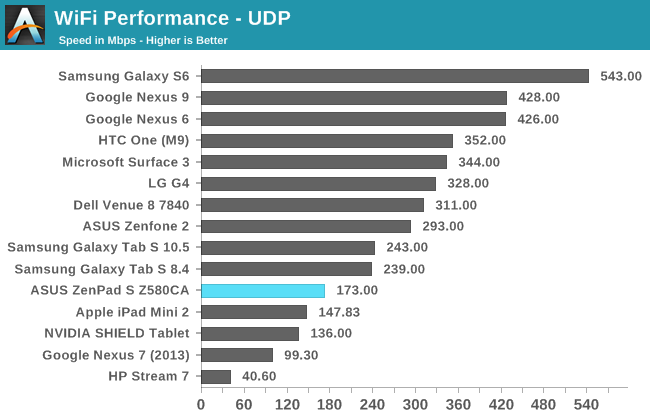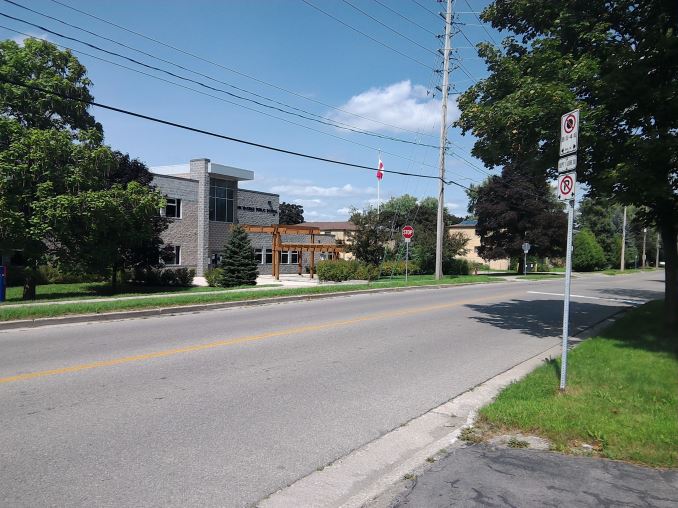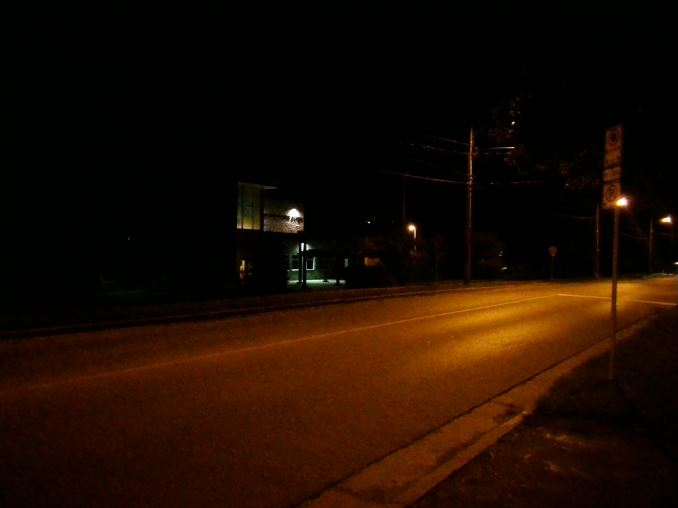The ASUS ZenPad S (Z580CA) Review
by Brandon Chester on August 31, 2015 8:00 AM ESTCamera
While most people will use either their smartphone or a dedicated camera for taking photos, a tablet can be used in a pinch. Some people even make their tablet their primary camera, whether it be because it's their only device, or because they prefer the larger viewfinder that a tablet offers. While many may still find the idea of taking photos with a tablet to be absurd, one need only look at the people around them to see that for one reason or another tablet photography has become a way that some users choose take photos.
The ZenPad S Z580C sports a 5MP rear-facing camera, and the Z580CA bumps that to an 8MP sensor. Since resolution is only one of many aspects of a device's camera system, I've included some more information about the ZenPad S Z580CA's cameras in the chart below
| ZenPad S (Z580CA) Camera Specifications | |
| Front Camera | 5MP (2592x1944) |
| Front Camera - Sensor | Omnivision OV5670 (1.12 µm, 1/5") |
| Front Camera - Max Aperture | F/2.4 |
| Rear Camera | 8MP (3280x2464) |
| Rear Camera - Sensor | Toshiba T4K35 (1.12 µm, 1/4") |
| Rear Camera - Focal Length | 3.0mm (28mm eff) |
| Rear Camera - Max Aperture | F/2.0 |
The ZenPad has a similar camera stack to the ZenFone 2. Toshiba's T4K35 sensor has a resolution of 8MP with 1.12 micron pixels, while the ZenFone 2 used T4K37 which had the same pixel size but a higher 13MP resolution. Lens aperture and focal length end up being the same as the ZenFone 2 as well.
To evaluate the still image quality of the ZenPad S I've taken photos of my standard photo scene during the day and at night, and compared the results to the other tablets that I have available for testing which includes the Nexus 9, the iPad Air 2, and the Dell Venue 10 7040.
It's clear that the ZenPad S suffers from the exact same processing issues as the ZenFone 2. There's far too much sharpening of the image as well aggressive noise reduction. This can be easily seen in any of the foliage in the frame, and in the lines separating the bricks of the school walls. There's also noise across the entire sky, despite this photo being taken with enough light for the camera to shoot at the base ISO of 50. The still image section of my ZenFone 2 review goes into more detail on these issues, and it's disappointing to see that none of them have been resolved. Relative to the other tablets in my comparison, I would have to say that the ZenPad S takes the lowest quality photos. The exposure and color accuracy is much higher than the Dell Venue 10, but the extreme oversharpening and heavy noise reduction makes the image look more like a painting than a photo.
In low light the ZenPad S continues to perform poorly. Low light scenes really make it clear how much of a photo's quality has to do with the quality of the image processing performed. Both the Nexus 9 and iPad Air 2 share a sensor size and resolution with the ZenPad S, and both actually have smaller apertures. Despite this, they both have a better exposure and a much greater level of detail than the ZenPad S. Unlike the day photo test, I would say that the ZenPad S did take a better photo than the Dell Venue 10, but only because I can't even begin to describe the problems with the Venue 10's photo.
Ultimately, the ZenPad S suffers from the exact same issue as the ZenFone 2, which is poor image processing. The color rendition and exposure of images taken during the day makes it clear that the camera has potential, but the numerous issues with the processing produces poor quality images.
WiFi Performance
Like the ZenFone 2, the ZenPad S Z580CA uses Broadcom's BCM4339 WiFi + Bluetooth solution for wireless connectivity. The implementation in the ZenPad S supports two spatial streams on 802.11ac, which allows for a peak theoretical link speed of 867Mbps. However, the ZenPad S has a software problem that makes real world speeds significantly lower than that.

You may be wondering why the ZenPad S can only get a maximum speed of 173Mbps over UDP when the ZenFone 2 with its 1x1 802.11ac goes as fast as 293Mbps. You may have also noticed that a speed around 150Mbps is very similar to devices with 2x2 802.11n WiFi, and that's exactly the problem. The ZenPad S only works in 802.11n mode, a software problem that should have been found in testing long before the tablet actually shipped. I have tested the ZenPad S with an Apple Airport Extreme 6th gen and a TP-Link Archer C7, and the max link speed remains at 200Mbps in both cases. ASUS has confirmed the issue on their end and is aware of it, and so a software fix should arrive for it at some point. Users are, at the moment, just going to have to live with WiFi that isn't even half as fast as it would be if it was working properly.






















114 Comments
View All Comments
kmmatney - Monday, August 31, 2015 - link
Having both a 16:9 windows tablet and an iPad, IMO 4:3 is better. Who plays "immersive" games on there tablet? - that's what a computer or laptop is for. For typical things you use a tablet for - web browsing, reading emails, reading books, you tube, various other consumption, the 4:3 aspect ratio is perfect. I don't pretend to do any serious work on my tablets, but I wish my windows tablet was 4:3. There is a reason why the MS Surface tablets no longer use a 16:9 aspect ratio.boeush - Monday, August 31, 2015 - link
This is getting pretty stupid... Let's say your tablet is x inches long. Does it really make that much difference whether it's height gives 19:10 ot 4:3 AR? Unlike a phone, you aren't about to shove that tablet into a pocket. So is it REALLY so TERRIBLE that you have extra vertical screen space when watching a movie in landscape? Yeah, instead of that extra screen you could just have empty space I guess - but that still won't make your tablet all that more compact anyway (with the horizontal dimension being dominant.) So boo-hoo, you get top and bottom sidebars on your video. Contrast that with the use cases where you need/want that extra height in your landscape mode, or the extra width in portrait - and DON'T HAVE IT because your tablet is built oblong and that's that. Seriously, I for one would rather have extra screen space I don't need under certain circumstances, rather than at other times needing the extra space and not having it!keltypack - Monday, August 31, 2015 - link
I totally agree with the 4:3 aspect ratio. I don't know what people are thinking, but a tablet is a GREAT way to watch a movie on an airplane. The 16:9 ratio is much better for reading books. I don't understand the Apple fascination with 4:3. To be fair, I think 3:2 is a better aspect ratio than 16:9, but maybe that is the old-school photographer in me.uhuznaa - Monday, August 31, 2015 - link
16:9 sucks for websites and more compley apps though, both in portrait (too narrow) and in landscape (with some toolbars around you see only a small sliver and when typing into a form there's hardly any content left).But yes, if you're mainly watching movies with your tablet, 16:9 is better.
sonny73n - Tuesday, September 1, 2015 - link
The only reason 16:9 is better for movies because all HD contents are in 16:9. But to me, 16:9 is just odd and stupid. I remember when the first wave of HDTV hit the market, there was a widescreen trend. So bad they even started making movies wider than 16:9 - something really odd like 1920x818 instead of the 1920x1080.16:9 is horrible even on phones. Keyboard in landscape mode blocks more than 50% of the screen. You can have a 4.7in 1280x768 screen looks as big as a 5in 1280x720. 16:9 sucks, movies too. I'd rather see movies in 2:3 format.
BurntMyBacon - Wednesday, September 2, 2015 - link
@sonny73n: 16:10 more accurately maps to the active area of the human visual system and thus gives a more immersive experience at the appropriate screen size / viewing distance. 16:9 was just cost cutting measure by reducing the probability of defects in a screen given the statistical probability of localization. Problem is, you can't interact with your tablet when it's in your face. Most people don't sit that close to a TV either. Usability on 16:9 isn't very good. It is better at 16:10, but 4:3 or 3:2 can make more sense in a lot of cases. I personally prefer 16:10 (1280x800 in your example above), but a lot of that depends on how the tools you use are laid out.R. Hunt - Tuesday, September 1, 2015 - link
Apps look so much more natural in 4:3 IMO. Web browsing, and PDF reading are also better. I think, specially for large tablets, a squarer aspect ratio is overall the better choice. My Tab Pro 10.1 looks and feels really awkward in portrait (and unnecessarily long). I'll be getting the Tab S2 soon, no doubt.BurntMyBacon - Wednesday, September 2, 2015 - link
@keltypack: Yes. Your 3:2 preference is the old school photographer in you. Nothin wrong with that.retrospooty - Monday, August 31, 2015 - link
jjj, I think you need to put the pipe down.Puck85 - Thursday, September 10, 2015 - link
serious question: what should I buy instead of this around this price range?